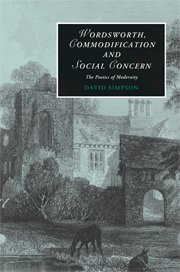Book contents
- Frontmatter
- Contents
- Acknowledgments
- CAMBRIDGE STUDIES IN ROMANTICISM
- Introduction: the ghost and the machine: spectral modernity
- 1 At the limits of sympathy
- 2 At home with homelessness
- 3 Figures in the mist
- 4 Timing modernity: around 1800
- 5 The ghostliness of things
- 6 Living images, still lives
- 7 The scene of reading
- Notes
- Bibliography
- Index
Introduction: the ghost and the machine: spectral modernity
Published online by Cambridge University Press: 15 September 2009
- Frontmatter
- Contents
- Acknowledgments
- CAMBRIDGE STUDIES IN ROMANTICISM
- Introduction: the ghost and the machine: spectral modernity
- 1 At the limits of sympathy
- 2 At home with homelessness
- 3 Figures in the mist
- 4 Timing modernity: around 1800
- 5 The ghostliness of things
- 6 Living images, still lives
- 7 The scene of reading
- Notes
- Bibliography
- Index
Summary
William Wordsworth had good cause to be preoccupied by death. His mother died a month before his eighth birthday and his father when he was thirteen. Later in life he suffered the devastating loss of two children, Thomas and Catherine, as well as of his beloved brother John. Such personal tragedies were less exceptional then than they are now among those similarly circumstanced, but they affected him deeply, and they go some way toward explaining why his poetry is haunted by ghostly apparitions, figures of death-in-life, of life shadowed and sometimes claimed by death. In addition the early support for his promising but still uncertain career came from a legacy established by the death of his friend Raisley Calvert.
There was more, much more, that was not personal but which Wordsworth registered in deeply idiosyncratic terms. He became a poet during a period of global warfare involving massive mobilizations of armies and navies and appalling fatalities, many from military combat but many more from the sickness and disease contracted abroad and carried home by the discharged and disabled veterans of foreign wars. Death-dealing economic changes also darkened his imaginative horizon: rural depopulation and the increasing spread of mechanized labor and factory discipline that damaged human bodies just as visibly as did weapons of war. At first glance Wordsworth's poetry looks nothing like Blake's impassioned vision of dark satanic mills, but on closer inspection it registers similar and perhaps even more pervasive marks of weakness and of woe.
- Type
- Chapter
- Information
- Wordsworth, Commodification, and Social ConcernThe Poetics of Modernity, pp. 1 - 16Publisher: Cambridge University PressPrint publication year: 2009



